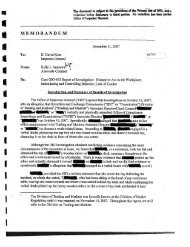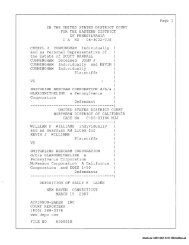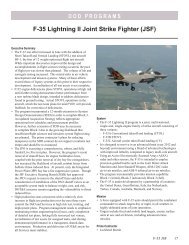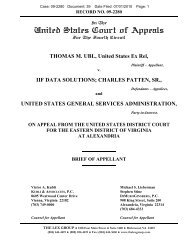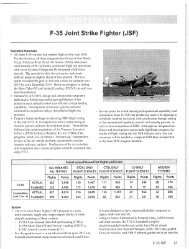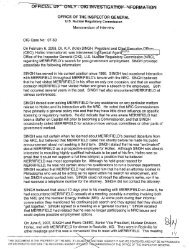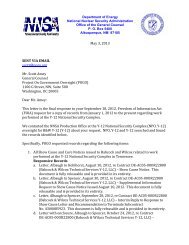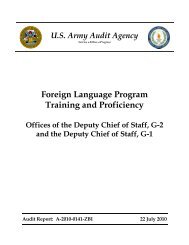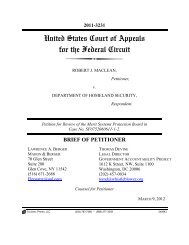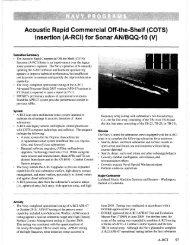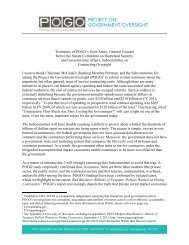F-35 Joint Strike Fighter (JSF)
F-35 Joint Strike Fighter (JSF)
F-35 Joint Strike Fighter (JSF)
Create successful ePaper yourself
Turn your PDF publications into a flip-book with our unique Google optimized e-Paper software.
Suite of Integrated Radio Frequency Countermeasures<br />
(SIRFC) AN/ALQ 211<br />
Executive Summary<br />
Army Speeial Operations Command<br />
• After a lengthy engineering investigation the Suite of<br />
Integrated Radio Frequency Countermeasures (SIRFC)<br />
Program Office directed a complete redesign of the radio<br />
frequency (RF) switch that was the primary source of poor<br />
system reliability. The Army was scheduled to receive the<br />
newly designed switch in late 20J0 and should complete<br />
additional qualification testing in early 20<br />
• Because of continued delays in resolving the RF switch<br />
reliability problem, DOT&E published the SIRFC IOT&E<br />
report to Congress in October 20J0. In previous reporting,<br />
DOT&E stated that SIRFC was operationally effective<br />
based on preliminary analysis of operational test results.<br />
However, upon completion of a comprehensive analysis<br />
of all test data in context with SIR ['Cs ability to support<br />
operational mission accomplishment- DOT&E determined<br />
that the initial effectiveness assessment was incorrect- The<br />
final assessment (characterized below) and supporting<br />
analysis is included in the October 2010 IOT&E report.<br />
• DOT&E assessed that SIRF(' was not operationally<br />
effective and remains not operationally suitable- SIRFC<br />
does not provide sufficient survivability even with current<br />
aircrew tactics to allow penetration in to the weapon<br />
engagement zone of many current radar-guided threat<br />
systems. Pending successful qualification and flight<br />
testing of the new RF switch, the SIRFC system should be<br />
operationally suitable.<br />
• SIRFC provides more capability than the legacy RF<br />
countermeasures systems on the MH-d7 and MI 1-60<br />
aircraft: nonetheless, it is not effective against its intended<br />
threat environment.<br />
The SIRFC radar warning sub-system, which can operate<br />
separately from the RF countermeasures portion, provides<br />
aircrew with excellent situational awareness, rapidly<br />
detecting, identifying, and providing accurate relative<br />
bearing to threat radar systems-<br />
Air Force Special Operations Command and Navy<br />
• DOT&E released the CV-22 OT&E Report in<br />
January 2010. assessing SIRFC integration on that aircraft<br />
as not effective and not suitable.<br />
System<br />
• SIRFC is an advanced radio frequency self-protection system<br />
designed for installation on aircraft-<br />
• Major SIRFC subsystems are:<br />
- Advanced threat Radar Warning Receivers<br />
(Numbers 1, 2, 3. 6, and 9 in picture)<br />
1 LRU (Line Replaceable Unit) Receive Processor 6 - Electrical Assembly<br />
2 Receive Antenna 7 - LRU High Power Receive Transmit<br />
3 Amplifier 8 • Transmit Antenna<br />
4 LRU Advanced Countermeasure 9 - Cockpit Display<br />
5 Radlo Frequency Switch Assembly<br />
- Advanced threat radar jammer/Electronic Countermeasures<br />
(Numbers 4, 5, 7, and 8 in picture)<br />
SIRFC is integrated onto Army Special Operations Command<br />
(ASOC) MH-47 and MH-60 helicopters and Air Force Special<br />
Operations Command (AFSOC) CV-22 tilt rotor aircraft. The<br />
AFSOC CV-22 aircraft is supported by the Navy V-22 <strong>Joint</strong><br />
Program Office (PMA-275)-<br />
• The SIRFC system integration is 90 percent common between<br />
the Service platforms, though the Army MH-47 and MI-60<br />
aircraft have a higher power transmitter installed, Early<br />
integration challenges on the A FSOC CV-22 aircraft dictated<br />
the installation or a lower power transmitter. Future CV-22<br />
block upgrades are scheduled to incorporate a higher power<br />
transmitter-<br />
Mission<br />
Special Operations Forces will use SIRFC to enhance the<br />
survivability of aircraft on missions that penetrate hostile areas-<br />
SIRFC-equipped units should be able to provide self-protection<br />
against threat radar-guided weapons systems by:<br />
• Improving aircrew Situational Awareness and threat warning<br />
• Employment of active electronic jamming countermeasures<br />
• Expending countermeasures (i.e-, chatf)<br />
Major Contractor<br />
ITT Electronics Systems — Clifton, New Jersey<br />
SIRFC 41



